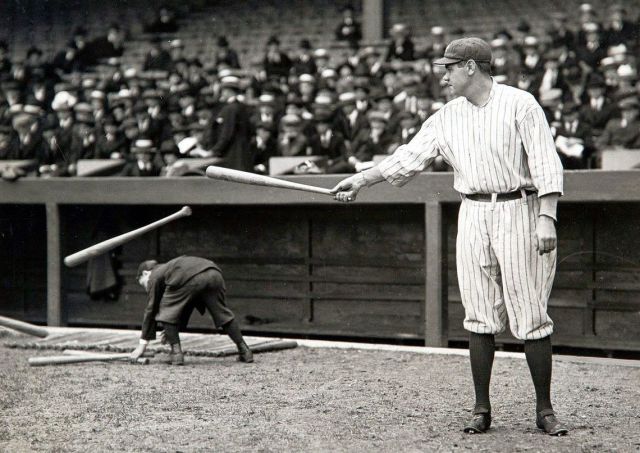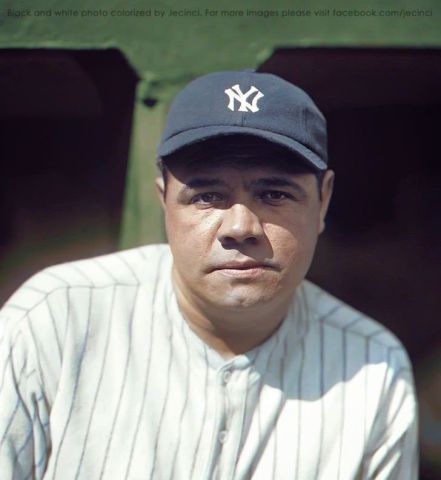-
Posts
21489 -
Joined
-
Days Won
82
Content Type
Profiles
Forums
Downloads
Everything posted by Yankee4Life
-
8 out of 10, 67 seconds. A mediocre way to start off February. We only have twenty-eight days this month and the last day is a Friday so that means we will be ending the month on a high note. Here are the final results for January.
-
10 out of 10, 30 seconds. That's my best score in a long time. Like the rest of you we have to take advantage of Fridays and Sundays. This was like the exact opposite of last month. Now that we have one more player it will be tougher next month. Thank you!
-
And what is your point?
-
5 out of 10, 67 seconds. As usual, Thursdays get me every week.
-
9 out of 10, 77 seconds. For those difficult Wednesday questions this was all I could ask for.
-
7 out of 10, 50 seconds. Thank you for no rugby questions!
-
6 out of 10, 67 seconds. I had two questions from baseball in the 1800's. I am not too good on that era.
-
I am sorry KC, I was not feeling well this morning so I could not come in here. Your response here was head and shoulders above mine so obviously the right person responded. Thank you.
-
I understand. 1959 was just a pennant winner for them.
-
Do you remember the question Jim? And this has happened to me a lot.
-
10 out of 10, 35 seconds. You have to take advantage of Fridays and Sundays. What position did Goose Gossage play? That is one that they hand you on a silver platter and I took it. 😉
-
9 out of 10, 55 seconds. I missed a gimmee question about Kirby Puckett being elected into the Hall of Fame.
-
10 out of 10, 42 seconds. I should have been faster. I went back to check if I did not skip over a question. Stupid on my part.
-
8 out of 10, 57 seconds. I never expect to do well on Thursdays because I am always thrown questions from soccer and rugby that I don't know.
-
5 out of 10, 71 seconds. Would you believe I got the first four right and then it went downhill from there.
-
5 out of 10, 57 seconds. The ones I missed I deserved to. I had no clue.
-
10 out of 10, 46 seconds. I'm surprised I got them all right. Some were tricky.
-
Yeah he did that in 1977. The Braves were doing so bad that he made himself the manager. Bowie Kuhn stepped in and stopped it after one game. I think I had a pretty good game and then I see this! Good going Jim! 👍
-
10 out of 10, 32 seconds. That was needed especially looking at a hard week ahead.
-
7 out of 10, 76 seconds. Nothing to be happy about today.
-

Great and Historical Games of the Past
Yankee4Life replied to Yankee4Life's topic in Baseball History
September 30, 1927: Babe Ruth hits record 60th home run Baseball history is filled with accounts of memorable home runs. The Los Angeles Dodgers’ Kirk Gibson, for one, knocked a one-legged homer in Game One of the 1988 World Series against the Oakland A’s. The Pittsburgh Pirates’ Bill Mazeroski hit a dramatic round-tripper in Game Seven of the 1960 fall classic to beat the New York Yankees. Bobby Thomson ripped his “Shot Heard Round the World” in Game Three of the 1951 National League playoffs, leading the New York Giants over the Brooklyn Dodgers. Decades before those epic clouts came another great home run, hit September 30, 1927, at Yankee Stadium in the Bronx, New York. Yankees slugger Babe Ruth belted his 60th home run of the season, breaking the record of 59 he set in 1921. While it was a happy day for many given the magnitude of Ruth’s accomplishment, it was also a sad day for some. Baseball said goodbye to one of the greatest pitchers of all-time, Walter Johnson. The legendary Big Train was retiring after 21 seasons with the Washington Senators. On the mound for the Yankees (who were in first place by a whopping 18½ games) that day was right-hander George Pipgras, sporting a record of 10-3. The Senators (who were in third place and trailed the Yankees by 23½ games) countered with left-hander Tom Zachary, who had a record of 8-12. Both lineups were loaded with talent. The Senators featured Sam Rice, Bucky Harris, Goose Goslin, and Joe Judge. Of course, the Yankees boasted a lineup famously referred to as “Murderers’ Row.” Earle Combs led off, followed by Mark Koenig, Babe Ruth, Lou Gehrig, Bob Meusel, and Tony Lazzeri in the two-through-six spots. The Yankees had clinched the pennant early in the month and were getting ready to face the Pittsburgh Pirates in Game One of the World Series on October 5. It was a relatively easy first inning for Pipgras as he quickly got a groundout and a fly out. Babe Ganzel singled, but Goslin popped out to Koenig at shortstop for the third out. In the Yankees’ half of the first, Combs flied out to left field and Koenig grounded out. Ruth drew a walk but was stranded after Gehrig’s groundout. Through the first three innings, the game was scoreless. Each team had managed just one hit. Things heated up offensively in the fourth inning. Goslin singled with one out for Washington, advanced to second base on Judge’s groundout to first and scored on Muddy Ruel’s single. Ruel then stole second and went home on Ossie Bluege’s base hit to make the score 2-0. Bluege stole second base but was left stranded when Grant Gillis grounded out. New York came back with a run of its own in the bottom of the fourth. Ruth led off with a single, followed by a base hit from Gehrig. Ruth advanced to third on the hit, while Gehrig went to second on the throw to third. Meusel hit a fly ball that scored Ruth and sent Gehrig to third. Lazzeri lined into a double play to end the frame. Goslin and Judge flied out to begin the Washington sixth. Ruel walked and made it to third after a pickoff attempt by Pipgras and subsequent error by Gehrig. Ossie Bluege walked, but Gillis flied out to end the inning. The Yankees tied the game, 2-2, in the bottom of the sixth inning. Ruth singled to right field with two outs and advanced to second on Gehrig’s single. Meusel followed with an RBI hit to score Ruth. Lazzeri popped out to end the rally. Herb Pennock, the Yankees’ ace left-hander, replaced Pipgras on the mound to open the seventh. He got Zachary to fly out and then gave up a double to Sam Rice. Bucky Harris walked, putting runners on first and second base. Ganzel grounded out, advancing Rice to third and Harris to second. Harris was then picked off second base for the third out. New York went down in order in the bottom of the seventh with Joe Dugan fouling out, Benny Bengough popping out, and Pennock flying out to left field. Pennock, in turn, retired the Senators in order in the eighth. Goslin and Judge grounded out, and Ruel flied out to left field. The game was getting late. Combs grounded out to third base to open the New York eighth. Mark Koenig tripled and up to the plate stepped the Bambino, Babe Ruth. In Ruth’s time with the Yankees, he had hit 366 home runs. Now, he was ready to blast another record-breaker. With his slugging prowess, Ruth had changed the way the game of baseball was played. He broke the single-season home-run mark in three straight seasons, in 1919 (29), 1920 (54), and 1921 (59). Babe had moved into first place on the all-time homer list in 1921 with No. 139. Zachary delivered a low fastball that Ruth sent into the right-field stands for number 60 on the year. It was also number 17 for the month of September and it gave the Yankees a 4-2 lead. Gehrig flied out to right field, and Meusel flied out to center field. The Yankees took their lead into the top of the ninth inning. Pennock got Bluege to fly out to left field, and then Gillis grounded out. The Senators were down to their last out. With Zachary due up, player-manager Bucky Harris sent in Walter Johnson to pinch-hit. The Big Train was a career .235 batter. In what would be Johnson’s last appearance in uniform as a player, he flied out to Ruth in right field. (Johnson had made his last appearance as a pitcher on September 22. He started against the St. Louis Browns and gave up nine hits and six runs in just 3⅓ innings.) Johnson subsequently asked for his release from the Senators. He still had the arm to pitch, but had lost the power generated from his legs. During spring training Johnson had suffered a broken ankle while pitching batting practice. While he somewhat recovered, the injury reduced the power generated from his legs. Despite his arm remaining sound, Johnson realized the end was at hand. “The leg I broke bothers me a lot, and not where it was broken. You see, when the legs are bad and you lose the old ‘zip’ on the ball, you find pitching a lot harder and you find you are not effective.” The Big Train went just 5-6 with a 5.10 ERA in his final season. -
10 out of 10, 36 seconds. I'm just trying to keep up with you guys!
-
10 out of 10?? On a Thursday??? Only in my dreams can I get this!
-
7 out of 10, 67 seconds. I am slowly falling apart over here.
-
9 out of 10, 75 seconds. A lot slower today but there were some head scratchers in here.





